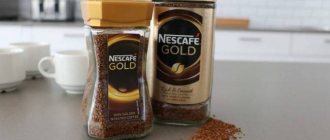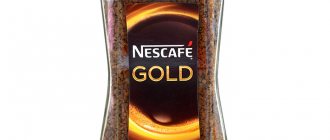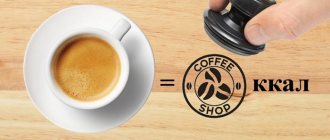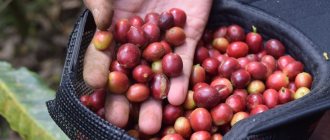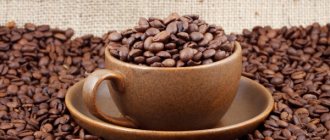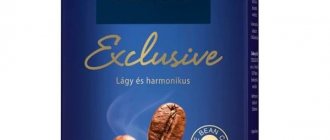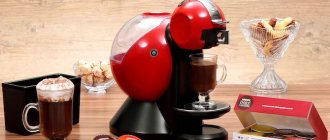Many of us brew aromatic, invigorating coffee every morning. It gives strength and energy for the coming day. A cup of coffee and a fresh croissant, what could be better? Now, there is a huge selection of coffee products on the market that differ in taste, quality and different prices. One of them is Nescafe coffee, which we will talk about today.
History of the brand
The brand name was formed by combining the words Nestle and Cafe, this happened in 1938. Nine years earlier, the Swiss company Nestle, led by Louis Dapplet, specializing in the production of baby food and condensed milk, made an offer they could not refuse. A large amount of coffee beans was stored in the Brazilian warehouses of the bank servicing the company. The crisis did not allow selling all stocks; a new harvest was on the way, and the remains of the old one could become moldy.
A large amount of leftover beans in the warehouse became the beginning of the production of a new type of coffee
In such a hopeless situation, the bank offered the then small company to expand its production range and, with the help of its chemists, create a product that would be stored for a long time and could be immediately consumed in dissolved form.
For these difficult tasks, the Swiss chemist Max Morgenthaler was invited to the company. He spent four years searching for the perfect instant coffee. Initial results were not ideal and had problems with solubility and lack of proper taste. Sugar and milk powder only made the situation worse.
It was only in 1937 that Max showed the finished product to the company's management, and in the spring of 1938 the first instant coffee under the Nescafe brand was presented to Swiss customers. Within a year the coffee was sold in Britain and the USA, and after another year it could be found in 30 countries around the world.
Instant coffee was first produced under the Nescafe brand.
After World War II, the new product began to take over the whole world. The company began producing not only instant coffee, but also related products: foaming blenders, coffee makers and coffee machines.
Nescafe Green Blend
Nescafe Green Blend is not only a delicious and invigorating coffee, but also an elixir of female youth and beauty. This effect is due to the unusual combination of green, unroasted and roasted coffee beans. Thanks to this, the drink contains the same amount of antioxidants as green tea, but they are absorbed much better. The taste of this coffee is quite unusual, very delicate and fresh. You can buy it in a 100 gram glass jar, 70 and 150 gram soft packaging.
Raw materials and production process
The most common coffee varieties are Arabica Robusta. Robusta beans are distinguished by a high caffeine content, which gives the coffee strength and a pleasant, rich aroma and bitterness. Arabica, on the contrary, is characterized by a small amount of caffeine and contains more essential oils. It has a mild taste and a sweetish aftertaste with sourness.
Coffee beans are carefully collected by hand
The process of collecting coffee beans has not changed over time. The grains are still collected by hand. They are then cleared of their outer shells. Next, usually by hand, the best quality grains are selected to go into production. The main plantations are located in Brazil, Indonesia, Peru, Colombia, Vietnam, i.e. in the coffee belt countries.
In coffee factories, instant coffee is produced mainly in two ways. The first one is more budget-friendly and is called agglomeration. The resulting beans are ground in large coffee grinders, the resulting powder is diluted with water, resulting in an extract that is exposed to hot air, the water from the solution dissolves and soluble coffee granules remain.
Grinding of grains is done in large machines
The second method is more modern - freeze drying. But its costs are significantly higher than those of agglomeration. The method involves freezing the coffee extract and then using hot air and vacuum to dehydrate the extract. The coffee breaks into small pieces that resemble broken ice. This type of preparation preserves the taste, aroma and beneficial properties of coffee as much as possible.
The company has opened 447 factories in 86 countries, employing more than 300 thousand people.
Estimated composition of raw materials
Experts from independent groups that study food products in the laboratory have long concluded that soluble coffee beans contain no more than 20%. Everything else is acorns, chestnuts, cereals, rose hips, chicory, fruit pits and all other food waste.
It is clear that such data is not disclosed - reports can be found in the laboratories themselves. YES, it is not profitable for manufacturing companies to start scandals.
Coffee rulers
There are a large number of Nescafe coffee lines around the world. Each of them has its own unique qualities, so everyone can find their favorite taste. Each region has its own individual set of product lines and types. There are 4 product lines in Russia: Gold, Classic, Sensa and 3 in 1.
NESCAFE Gold (Gold)
Made from Arabica and Robusta beans. It is one of the oldest types of coffee from the brand; it began to be produced back in 1965. The raw materials are characterized by ultra-fine grinding, which allows the taste and aroma to develop more strongly. It is considered a “premium” product, although it is not the most expensive. It has a pleasant caramel aroma during cooking. Due to its light roasting, it has a mild taste.
Nescafe Gold is made from a mixture of Arabica and Robusta.
This type of coffee is perfect for making Tiramisu cocktail. To prepare it you will need 90 ml of freshly brewed Nescafe Gold coffee, 400 ml of high fat cream, 40 ml each of Amaretto and Tiramisu syrup. Beat the syrups with cream and pour the resulting cream onto the coffee base. Decorate with cocoa if desired.
Nescafe Gold Barista (Gold Barista)
The granules are obtained by sublimation, which is why the cost is quite high. The beans are perfectly roasted and the finest Arabica beans are added to the finished product. The best grains are selected for the product and undergo the strictest selection. Strong coffee with a rich aroma.
Nescafe Gold Barista is made from ground Arabica coffee.
For those who like to experiment, Barakito coffee is perfect! To prepare a couple of cups of coffee you will need: 60 ml condensed milk, 30 ml coffee syrup, 120 ml Gold Barista coffee, 30 ml milk foam. Layer condensed milk and syrup, coffee and foam into cups. To serve, garnish with lemon zest.
Nescafe Gold Crema (Gold Crema)
The character of this drink is already reflected in the name - it has a soft, velvety foam that will allow you to fully enjoy the taste and aroma, and underneath it is bright, strong coffee. Belongs to the middle price category.
Nescafe Gold Crema forms a lush foam when brewed
What can you prepare for coffee with foam? Latte of course! It is necessary to brew 50 ml of coffee until foam forms, if desired, add 2 teaspoons of sugar for sweetness. Next, heat the milk to 60 degrees Celsius and beat half of it with a blender or mixer until foam appears. Pour the coffee into a cup of milk and carefully place the resulting foam on top.
Nescafe Gold Cappuccino (Gold Cappuccino)
One of the oldest names for coffee, as it began to be produced under the Nestle brand, the formula by which this coffee is produced now dates back to 1987. There are several subtypes of the drink on the market: with caramel or mild flavor, strong, classic and in 3-in-1 sticks. Many coffee connoisseurs like it for its simplicity, pure taste and voluminous head.
Aromatic coffee with milk foam, available in several packaging options
There are a lot of options for making cappuccino. Cappuccino with liqueur, ice cream, vanilla, cognac, and chocolate became widespread. For cappuccino with liqueur, you will need to brew 225 ml of coffee, 50 ml of heated milk, whip up the foam. Pour coffee liqueur and 50 ml of milk into a preheated ceramic mug and decorate everything with foam.
NESCAFE Classic
It can safely be called the most popular coffee of the Nescafe brand; it subtly captures the line between affordable price and good quality. Arabica and Robusta beans for coffee are grown on the best coffee plantations in Brazil. It is distinguished by a simple, but still recognizable bitter taste with a rich aroma. Perfect for many coffee drinks and a great way to invigorate you in the morning.
Classic is the basic taste in the Nescafe brand line
Nescafe Classic Crema
Combines the original taste and aroma of classic Nescafe and the tenderness and airiness of Gold Crema. For which you have to pay an above average price. Ready to drink on its own or in cocktails, ideally combined with sweets such as marshmallows or marshmallows.
Nescafe Classic Crema can be drunk with any sweet dessert
NESCAFE Sensa
Not so widespread and popular on the Russian market, unlike its counterparts. A representative of the premium segment, produced in the United Kingdom from Arabica beans. The most expensive of the brand representatives in Russia. Positioned as a drink straight from the best caffeine in the world. It has excellent foam and bright taste. You can choose Americano or Espresso.
Premium coffee, which is available in 2 varieties
NESCAFE 3 in 1
A quick option to boost your energy and quench your thirst at a low price. You can always take it with you on the road, since 3 in 1 is a ready-made combination of coffee, cream and sugar. Available in caramel flavor, in the classic version, cappuccino, Mild - the taste of delicate chocolate, and Strong - for those who like something stronger.
3 in 1 – an affordable coffee option sold in sticks
Nescafe Gold
Nescafe Gold is a premium aromatic coffee. As soon as you pour boiling water over it, the smell will be felt throughout the apartment. An exquisite blend of Arabica and Robusta beans, their gentle roasting provides a soft taste and light caramel aroma. On the market it is presented in glass jars of 200, 100 and 50 grams, as well as soft bags of 150 and 75 grams.
Reviews of Nescafe coffee
Customer reviews vary, because everyone has their own individual taste, but almost everyone does not remain indifferent to the already classic tastes of Nescafe coffee. Therefore, most people prefer this brand. Some people buy coffee because of the relatively low price, while others note that the manufacturer keeps the quality of taste high.
Some consumers do not find the coffee strong enough; some prefer to add milk and cream. But everyone agrees that the drink has a pleasant aroma. Most of the criticism is directed towards Nescafe 3 in 1, since it has practically nothing in common with real coffee, the taste and quality leave much to be desired.
Nescafe is the favorite drink of millions of people around the world.
Advantages and disadvantages of instant coffee
The only advantage of instant, freeze-dried and granulated coffee is the speed and ease of preparation. As long as your health is fine, which usually happens in youth. After several years of using chemicals, the liver stops performing its functions, and a person begins to feel unwell from questionable foods or drinks.
It makes no sense to consider the disadvantages of coffee if it is not one. Recommendation for those who love instant coffee: at the first sign of discomfort after drinking the powder, you need to switch to natural beans that you can see and touch with your hands. Even a ground packet does not provide as much confidence as an espresso made from freshly ground beans.
Counterfeits and how to spot them
Nescafe coffee is rarely counterfeited in large quantities. However, there are large quantities of counterfeit goods. So, from 2005 to 2006, a gang from St. Petersburg produced counterfeit goods and distributed them throughout major Russian cities. Production volumes were comparable to industrial production.
To distinguish the original from a fake, just look carefully at the packaging. It is necessary to pay attention to the price of coffee - a low price is a reason for caution.
Low-priced coffee may contain chicory or malt. The packaging will not be of the same quality and may lose its seal.
The markings on counterfeit cans are already on the cans, not glued on. It is extremely important to find the date, country of origin, and barcode. The first 3 digits of the barcode must match the country of origin code. And, of course, the taste, aroma and type of coffee granules will differ.
Also read about the origins of Dafidoff, Jacobs and Mehmet Efendi coffee brands.
Nescafe Espresso
Nescafe Espresso is selected Arabica beans, roasted to a dark color. This coffee is very similar to Italian, thanks to its strong, rich taste and delicate foam. The consistency of all grains is correct thanks to the latest technology based on the spraying of a liquid base. This type is most similar to freshly brewed coffee; it also goes well with cream and milk. Available in soft packages of 70 and 500 grams and in glass jars of 100 and 200 grams.
Nescafe "Classic 3 in 1"
As in the joke: these are not dumplings with mayonnaise, but mayonnaise with dumplings. So it is here: we have a whole range of sweeteners and chemical additives with a small addition of coffee.
One teaspoon of refined sugar contains 4.2 g of carbohydrates. It turns out that our drink contains almost 3 tablespoons of sugar. Not a bad start.
The creamer consists of glucose syrup, palm oil, sodium caseinate and various additives. For each additive with the “E” index, we will indicate the level of danger and origin (natural, artificial or synthetic), you can read more about this on the Additives.net website.
- Glucose syrup
is a harmful and cheap alternative to sugar. Glucose syrup does not cause an insulin response, as sugar does, and does not give a feeling of fullness. A striking example of a completely “empty” calorie content. You want to eat more and more sweets with glucose syrup. - Palm kernel oil
(obtained from the kernels of oil palm fruits) is a completely normal ingredient, a source of healthy fats and one of the few components of coffee that does not raise questions. - Sodium caseinate
is a milk protein and also does not raise any questions. - Salt.
There is no need for explanation here. - E340(ii) – potassium orthophosphate.
An artificial stabilizer, considered non-hazardous. - E331(iii) – sodium citrate.
A synthetic stabilizer, similar to salt, used to control acidity. Considered non-hazardous. - E451(i) – sodium triphosphate.
Synthetic powder, an acidity regulator, is harmless in small doses, but in overdose it can lead to calcium deposition in the kidneys, as well as the development of osteoporosis. Danger level: medium. - E452(i) – sodium polyphosphate.
An artificial stabilizer, used both in the food industry and in the chemical industry for the production of soap and washing powder. Danger level: low. - E471 – glycerol monostearate.
Artificial fatty acids, similar in structure to natural fats. Used in the production of mayonnaise, margarine and other fatty products. Danger level: low. - E472e – esters of glycerol, diacetyltartaric and fatty acids.
An artificial substance that imparts homogeneity, plasticity and viscosity, is widely used in the production of bread, cookies and candies. Considered non-hazardous. - E551 – silicon dioxide.
An artificial substance used to prevent caking and clumping of a product (emulsifier). Used in a wide variety of industries - from rubber and concrete production to optical fiber. Considered non-hazardous.
The manufacturer does not say what flavorings are used in the drink - this is allowed.
Caramelized burnt sugar is the same sugar. Salt is salt.
And finally, the last, rather controversial ingredient is the sweetener sodium cyclamate, E952. This is a synthetic sweetener, 30-50 times sweeter than sugar. Permitted in Russia, but since the 60s of the last century it has been banned in the USA as a possible carcinogen (data were obtained during experiments on mice). Now most experts believe that E952 does not directly increase the risk of cancer, but enhances the effect of other carcinogens. Danger level: high.
Oh yes, while listing all the ingredients, we forgot about coffee. Sorry. There really is coffee in the coffee drink.
